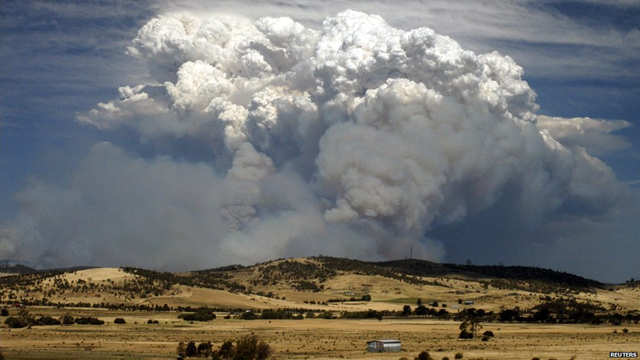Over 100 missing in Tasmania as ‘catastrophic’ fire conditions sweep Australia – ‘Perhaps the worst fire danger the state has ever faced’
6 January 2012 (BBC) – Australian police are searching fire-ravaged towns in southern Tasmania looking for 100 unaccounted people. Tasmania’s police commissioner said he feared lives may have been lost in the wildfires which swept through parts of the island in recent days. Almost 3,000 people have been evacuated from their homes, many stranded in emergency shelters. On Friday, Tasmania experienced its peak temperature since records began with levels hitting 41.8C. The national weather bureau has warned extremely hot conditions are expected across much of the country next week. Acting Tasmania Police Commissioner Scott Tilyard said about 100 remained unaccounted for. “That’s not to say that those people necessarily have come to any harm, but obviously we can’t totally eliminate that until we’ve had confirmed contact with those individuals,” Mr Tilyard said. […] More than 40 fires are still burning. On Sunday, firefighters issued an emergency warning for residents of Taranna, 29 miles (47km) east of the state capital, Hobart, where a fire has been burning for more than three days. […] The BBC’s Nick Bryant, in Sydney, says large swathes of south-east Australia are suffering from the worst fire conditions since the Black Saturday disaster almost four years ago, when 173 people in rural Victoria lost their lives. He says there has been a combination of a record-breaking heatwave, high winds, and drought, with Tasmania by far the worst hit. [more]
Australia bushfires: Tasmania search for 100 ‘missing’ 
By Ilya Gridneff and Peter Hannam
8 January 2013 (Sydney Morning Herald) – A ”dome of heat” is expected to push temperatures in NSW above 40 degrees, creating ”catastrophic” fire conditions. The Premier, Barry O’Farrell, made an emphatic appeal to all residents to be fully prepared for the worst as temperatures soared on Tuesday. ”[It] is not just going to be in the 40s. It will perhaps be the worst fire danger the state has ever faced,” he said. A total statewide fire ban was imposed last night. The Shoalhaven and Illawarra area and the southern ranges are the most at risk, categorised as having catastrophic conditions. Most of NSW – including Sydney, the ACT and the central west – is rated as ”extreme”, while in the far west and on the far south coast there are warnings of ”very high” fire danger. […] The Fire Commissioner, Greg Mullins, said: ”We are expecting extremely dangerous bushfire conditions, the likes of which haven’t been seen in NSW for many years. It is 19 years to the day that we saw more than 100 homes destroyed in southern and northern Sydney.” Mr O’Farrell urged campers and holidaymakers to head to safer ground as early as possible. Thousands of fire service personnel were on standby and canvassing areas at risk. ”Rethink your need to be in the bush, have a bushfire plan, be prepared but most importantly make sure you are well away from harm’s way,” he said. ”Don’t just think, [it] ‘is another bushfire danger day, tomorrow is another summer’s day’. ”[It] is going to be the worst fire danger day in parts of this state we’ve ever experienced.” In some towns in the far west the temperature is predicted to hit 45 degrees. In Sydney the mercury is forecast to reach 43 degrees. The hottest day on record for Sydney is 45.3, on January 14, 1939, followed by 44.2 on New Year’s Day, 2006. Experts have described a huge “dome of heat” over Australia that has broken national temperature records and set the scene for dangerous fire conditions for days across large parts of the country. Australia is likely to have posted a record average maximum on Monday, beating the previous high of 40.17 degrees on 21 December 1976, said Karl Braganza, manager of climate monitoring at the weather bureau. […] The NSW Rural Fire Service Commissioner, Shane Fitzsimmons, said winds of up to 80km/h would make things more difficult for emergency services. ”It’s not just the heat and winds but because there is so much dry fuel and little humidity, it’s going to be a shocking day,” he said. [more]
